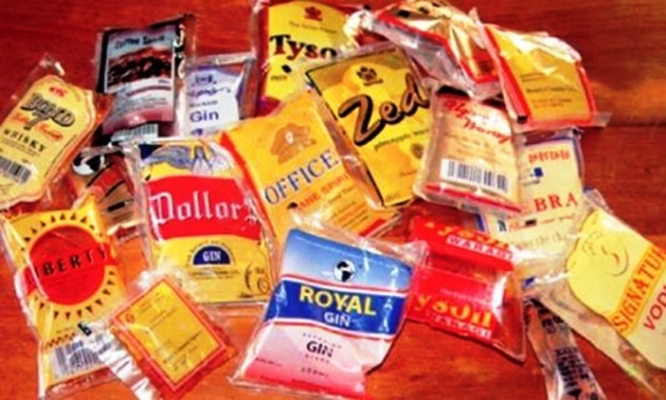High concentrations of
hazardous metals have been found in a number of alcoholic spirits consumed in
Uganda. The finding is a result of an intensive electronic analysis of samples
of different spirits consumed by Ugandans.
The scientific study was commissioned and conducted in a US Laboratory by Dr
Olara Otunnu, the former Under Secretary General of the United Nations and also
former President Uganda People’s Congress (UPC) Party and two leading members
of the academia in US State of California.
The Academia team included Ochan Otim, an environmental Chemist at the
University of Los Angeles and Tom Juma, an Environmental Monitoring Expert in
the City of Los Angeles, assisted by five Researchers from Uganda. Their
findings were published in a US open Source Scientific Journal, PLOS ONE, on
February 27.
The two separate Laboratory analyses were performed on 17 alcoholic gin samples
collected randomly from various places in Uganda over a space of two years. The
samples were subjected to intensive heating of 93 degrees centigrade for two
consecutive hours before they were analyzed for concentration of heavy metals.
The spirit samples include Uganda Waragi, Bond 7 Whisky, Chief Waragi, Ssalongo
Gin, Royal Vodka, Kick Gin Pineapple, and Brigade Gin. The others are Big 5
Vodka and Relax from King Albert Distilleries in Kampala, Goal Vodka, Beckham
Gin and V6 Tangawizi Vodka.
It also involved the use of samples of locally brewed Lira-Lira Gin randomly
collected from around Nsambya Police Barracks in Kampala, Teso Bar in Lira
Town, Awere and Bolo Trading Centres in Omoro district in Northern Uganda
alongside 13 samples of gins blended and packaged in Sachet of 100-millilitre
quantities each.
The gins were analyzed against a Scottish Whisky bought from San Diego in the
United States of America and against Standards set by the Uganda National
Bureau of Standards (UNBS).
The duplicate sachets sampled a year later included Goal Vodka, Kick Spirit,
Pineapple Waragi, Relax, Royal Vodka, Ssalongo Spirit, Uganda Waragi, and V6
Tangawizi Vodka. They were tested for the presence of silver, arsenic,
aluminum, barium, beryllium, cadmium, cobalt, chromium, copper, manganese,
molybdenum, nickel and lead. The others are antimony, selenium, tin, vanadium,
thallium, strontium and zinc.
Findings;
In their findings, the Chemists concluded that alcohol consumption in Northern
Uganda is significantly increasing health risks. They say quantitatively, they
found Copper presenting the highest concentrations recorded in any spirit brand
studied, followed by Barium and Manganese.
“Quantitatively, Copper had the highest concentrations recorded in any
spirit brand, followed by Barium and Manganese which were higher than the
combined levels of Selenium, Arsenic, Nickel, vanadium, Chromium, and Tin in
all brands” it states.
The brands found to contain the most metals mainly Copper were the locally
distilled Lira-Lira spirits with concentrations averaging 95 percent. The study
says that the levels of Copper in the brand exceed the World Health
Organization (WHO) guideline value of 2,000 micrograms per Liter by almost 100
percent in samples from Awere and 6,000 percent in Teso bar Samples.
“Excluding Copper levels from the Lira-Lira spirits exposes the Relax
brand as the most contaminated of all samples,” the chemists wrote in
their Journal Article.
They concluded that there is a direct relationship between high mortality rates
being experienced in the Acholi sub-region and consumption of the 17 spirits
contaminated with heavy metals. In Uganda, food contamination by heavy metals
is recognized as a serious health risk but not alcoholic drinks to the same
extent.
Assumptions of the Study
The study assumed that a contaminated alcoholic drink exposes a consumer to a
mixture of metals which could potentially interact and produce synergistic
effects in humans.
They observed that in blood, for example, non-essential elements such as
Thallium, Nickel, and Aluminum are strongly competitive with elements required
for the proper functions of the body such as Calcium, Magnesium, Zinc,
Selenium, Mn, Cobalt, Chromium, and Molybdenum.
It also assumed that an adult in the study area consumes 2.5 times a
100-Milliliter of 40 percent ethanol by volume sachet per day. For comparison,
one standard alcoholic drink by the World Health Organization is a 30-mL volume
of alcoholic drink.
It says that the overall picture of metals contamination in each waragi brand
is, therefore, important to understanding the potential health risks associated
with a waragi brand. It says no amount of alcohol appears to be safe, adding
that 34,000 cancer-related deaths were attributed to light drinking in a study
published in 2013.
“On the other hand, alcohol consumption is also associated with a decrease
in cancer of the kidney and non-Hodgkin lymphoma. These benefits, however, are
outweighed by harms done” the study report says.
The study calls for further study in the area and recommends that public
education about the health risks of excessive alcohol consumption must be
intensified. It adds that second, fun and productive socioeconomic activities
must be developed to engage people away from excessive drinking.
Biochemical roles of heavy metals in
cells
According to the study, the biochemical roles of heavy metals in various
oxidative states in cellular destruction are well known. Copper redox-coupled
with Iron, for example, is implicated in enhancing oxidative stress leading to
premature ageing.
The researchers state that toxic metals and organic pollutants in most cases
are carry-overs from the production processes although some are acquired
through exposure to polluted environments.
They say that lead is not a major health risk in Uganda’s waragi in comparison
to other heavy metals also found in waragi, or ethanol. They hope that their
findings will help authorities in Uganda in developing the necessary and
appropriate alcohol quality assurance standards and enforcement policies to
minimize health risks associated with unsafe alcohol consumption.
Uganda’s Sachet Waragi Contains Hazardous Metals – Study





